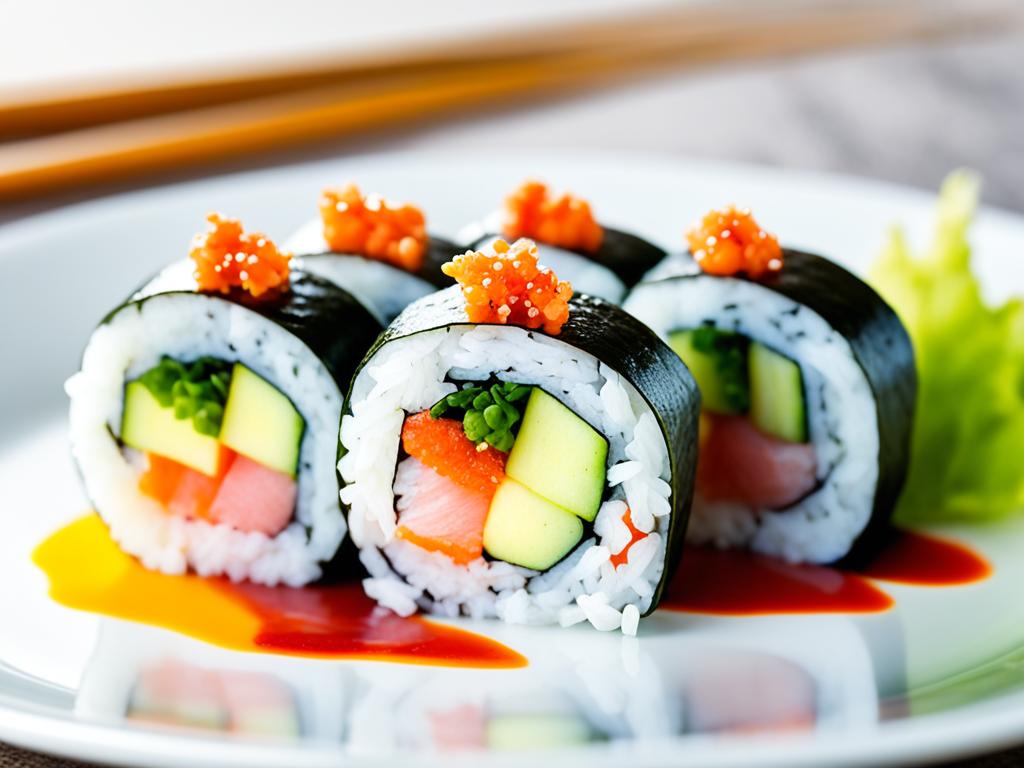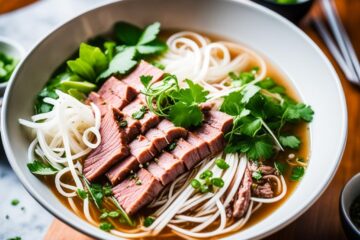Imagine you’re seated at a cozy table in Japan’s traditional sushi spot. You hear the chef’s knife slicing through fresh fish. You watch the chef create each piece of sushi with care. Soon, a beautifully made nigiri with sashimi appears before you. When you take the first bite, various flavors fill your mouth. This culinary experience takes you to a whole new world of delight.
Sushi is more than just Japanese food; it’s a beloved art form worldwide. It captivates us with its detailed tastes, bright colors, and elegant presentation. Whether you’re enjoying maki rolls or simpler nigiri, every bite is a new adventure. A combination of different flavors and textures makes every piece special.
Key Takeaways:
- Sushi (Japan) cuisine is a sensory experience that captivates the palate.
- The artistry behind sushi lies in the meticulous assembly and presentation of each piece.
- Sushi offers a diverse range of flavors and textures, from indulgent maki rolls to elegant nigiri.
- Each bite of sushi is a symphony of tastes that transports you to a world of culinary bliss.
- Explore the delights of sushi and experience the flavors that have enchanted taste buds for centuries.
Exploring the Variety of Sushi (Japan)
Let’s dive into the amazing world of Japanese sushi. We’ll talk about everything from the bright maki rolls to the elegant nigiri. You’ll see the true beauty and variety of sushi (Japan) cuisine.
The Artistry of Maki Rolls
Maki rolls are a big part of Japanese food because of their color and taste. These rolls are made with sushi rice and various ingredients all wrapped up. You can find many types, from classics made with raw fish to new ones with mixed flavors and textures.
They are cut into small pieces, making them great to share. You might like the California roll or the spicy tuna roll. Each roll is an adventure in taste.
The Simplicity and Elegance of Nigiri
Nigiri shows the beautiful simplicity of Japan’s sushi. It’s a little bit of rice with a slice of fish or something on top. The perfect mix of top quality ingredients and rice makes each piece special.
Every bite lets you taste the freshness of the fish or topping. People often eat it with a bit of wasabi and soy sauce. The skill in making each piece shows in the amazing mix of flavors.
The Importance of Fresh, High-Quality Ingredients
For great sushi, you need top quality, fresh ingredients for maki rolls or nigiri. Everything must be excellent, from the fish and rice to the vegetables. That’s the secret to amazing sushi.
Sushi chefs work hard to find the best ingredients. They always use trusted sources to keep quality high. This care for quality is what makes sushi (Japan) outshine others.
Visiting a sushi spot, you’ll find a wide range of choices. From the colorful maki to the elegant nigiri, each kind showcases skill and taste. Set out and explore the tastes of sushi (Japan) cuisine. Your tongue will thank you for it.
Conclusion
Sushi from Japan is not just food; it’s an art bringing together old traditions and new ideas. It showcases Japan’s rich culture through different kinds of sushi. You have classics like nigiri, creative maki rolls, and the light sashimi.
Enjoy the simple elegance of sashimi or the complex layers of a sushi roll. Eating sushi takes you on a taste adventure. Every bite blends top-quality ingredients prepared with skill and love.
To learn more about sushi’s story and how it’s made, check out the BCIT-Lee-2014. It gives you a look into sushi-making, showing the care and skill behind great sushi.
For info on a kinder way to make sushi that maintains fish quality, look into Ikejime in the SCMP article. Ikejime keeps the fish fresh, making your sushi experience better.




